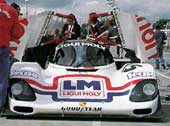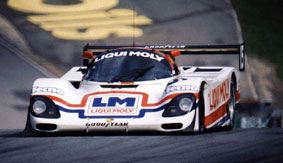
Die
Geschichte eines un-
gewöhnlichen Rennwagens

Als eines der ersten Kundenteams von Porsche begann Richard Lloyd Racing bereits 1984 den Porsche 956 zu modifizieren und hinsichtlich Gewicht und Aerodynamik zu optimieren. Nicht zuletzt um sich gegenüber der Konkurrenz und vor allem den Werksautos einen, wenn auch geringen, Wettbewerbsvorteil zu verschaffen.
Für die Saison 1987 ging Lloyd noch einen Schritt weiter und baute den „ultimativen“, von der Konkurrenz spöttisch „Porguar“ genannten light-weight 962 C. Der frühere Lotus F1 Designer Nigel Stroud baute das Fahrzeug radikal um und verwendete Alu- Honeycomb- Elemente zur Gewichtsoptimierung. Speziell der Vorderwagen wurde komplett neu aufgebaut, das Fahrzeugheck mit Motor und Getriebe jedoch blieb im Kern unverändert. Das Monocoque- Chassis wurde gegenüber der Werksausführung leichter, verwindungssteifer und – angenehmer Nebeneffekt- auch noch preiswerter. Der so runderneuerte 962 C Gti 106 b, wie das Auto nun hieß, brachte gerade mal 850 kg auf die Waage. Im Gegensatz zur Konkurrenz die 900 bis 950 kg mit sich rumschleppen musste war dies ein enormer Wettbewerbsvorteil. Dennoch gelang es Lloyd Racing in der Saison 1987 nur ein einziges Mal zu gewinnen.
Die
200 Meilen von Nürnberg auf dem Norisring beendeten Baldi / Palmer als Sieger.
Der Rest der Saison war bis auf einige wenige Ausnahmen geprägt von technischen
Problemen und daraus resultierenden Ausfällen.
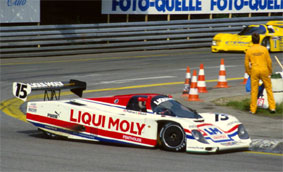
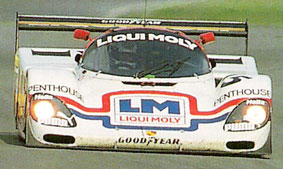
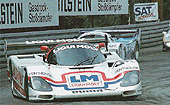
Team
Lloyd Results Group C Championship 1987 |
Date |
Race |
Drivers |
Result |
22.3. |
Jarama |
Baldi
/ Palmer |
8 |
29.3. |
Jerez |
Baldi
/ Palmer |
DNF |
12.4. |
Monza |
Baldi
/ Giacomelli |
DNF |
10.5. |
Silverstone |
Baldi
/ Palmer |
DNF |
13./14.6. |
Le
Mans |
Baldi
/ Palmer |
DNF |
28.6. |
Norisring |
Baldi
/ Palmer |
1 |
26.7. |
Brands
Hatch |
Baldi
/ Dumfries |
2 |
30.8. |
Nürburgring |
Baldi
/ Palmer |
5 |
13.9. |
Spa |
Baldi
/ Palmer |
DNF |
27.9. |
Fuji |
Baldi
/ Thackwell |
3 |
Thus to achieve an advantage
towards the works team and the other entries.
For the 1987 season Lloyd Racing
made a brave step forward and developed the “ultimative” 962 C, the so called
“Porguar”, also known as BLR 962 Gti 106 b. Former Lotus-designer Nigel Stroud
rebuilt the car in a radical way to save as much weight as possible and also
increase the stiffness of the monoqoque-chassis with the aim to make the overall
package more competitive. Especially the front end of the car was made more
or less from scratch while the rear end remained unchanged. This enabled the
team to use the works components like engine, transmission and gearbox “from
stock”. The final result of all these efforts was an ultralight car with a
reasonable good handling.
Despite all this the 1987 season
was an unlucky one for the team. The win at the Norisring-race was the sole
highlight of the season which brought only a few placements and a number of
failures which peaked in a total burn-out at Le Mans. This car was rebuilt
in only two weeks to win the Noris –race a fortnight later. Lloyd continued
the development of the car and raced these until the 1990 season which was
the last of the team.
The
history of a
unique racing car

